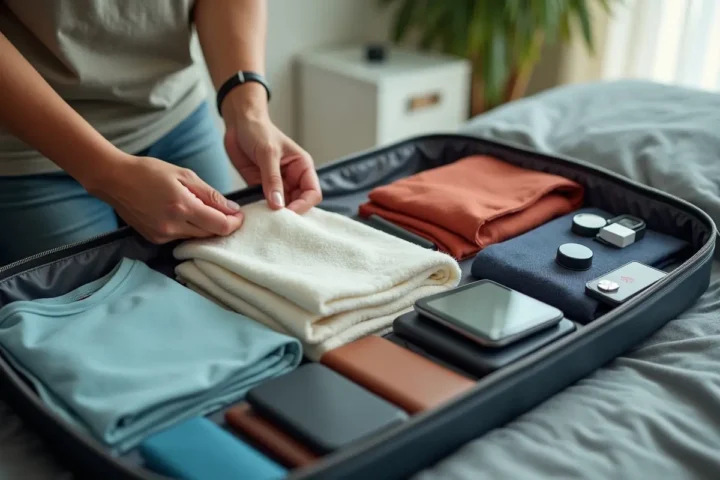Packing Smart: How to Fit Everything You Need in One Bag
Traveling with just one bag may seem impossible, but with the right approach, it’s not only achievable—it’s liberating. Whether you’re going on a weekend getaway, a business trip, or a month-long adventure, learning how to pack smart can make your journey smoother and more enjoyable.
Packing efficiently isn’t just about saving space; it’s about minimizing stress, improving mobility, and keeping everything you need within easy reach.

The Mindset of a Minimalist Traveler
Packing light begins with a shift in mindset. Many people overpack because they fear being unprepared, but the truth is that most of what we bring “just in case” ends up unused. Focus on versatility and necessity. The goal isn’t to fit your entire wardrobe into a single bag but to choose items that serve multiple purposes and can be mixed and matched.
Think carefully about your destination, climate, and activities. By planning ahead, you can make informed choices that keep your bag light and practical. Embracing a minimalist approach allows you to travel more freely and avoid the hassle of heavy luggage.
Planning Your Packing Strategy
Before you start folding clothes, take the time to plan. Make a list of essentials and stick to it. Visualizing what you’ll wear each day helps eliminate unnecessary items and ensures you pack only what you’ll actually use.
Also, consider the size and weight restrictions of your transportation. Airlines, trains, and buses often have different luggage policies, so knowing these ahead of time can prevent last-minute repacking. A well-planned strategy reduces stress and sets the tone for a smoother trip.
Choosing the Right Bag
Your choice of bag can make or break your packing success. Look for a lightweight, durable carry-on that maximizes internal space without exceeding airline size limits. Backpacks and duffel bags often offer more flexibility and better organization than traditional suitcases.
Compartments, compression straps, and expandable sections are your friends. These features help you stay organized while optimizing space. A well-designed bag not only fits everything you need but also makes it easier to access items quickly while on the move.
The Art of Efficient Packing
Mastering Clothing Choices
Clothing often takes up the most space, so this is where smart packing makes the biggest difference. Choose lightweight, wrinkle-resistant fabrics that can be layered and combined in various ways. Neutral colors are ideal because they mix and match easily, allowing you to create multiple outfits from a few pieces.
Limit bulky items like jackets or sweaters by wearing them during travel days. Shoes can also consume valuable space, so try to pack no more than two versatile pairs—one for daily wear and one for special occasions or specific activities.
Rolling vs. Folding
The way you pack your clothes can significantly affect how much you can fit. Rolling clothes instead of folding them not only saves space but also reduces wrinkles. For heavier items like jeans or sweaters, use a combination of rolling and folding to balance space efficiency and organization.
Compression packing cubes can also be a game changer. They allow you to categorize items by type and compress them to save room, making it easier to find what you need without unpacking everything.
Smart Packing for Essentials and Accessories
It’s easy to forget that accessories and small items add up quickly. Toiletries, electronics, and travel documents all take space, so packing them strategically is essential. Using a compact toiletry bag keeps hygiene products organized and contained, preventing spills and clutter. Opt for travel-sized items whenever possible, and remember that many destinations sell essentials you can purchase upon arrival.
Electronics should also be carefully curated. Do you really need a laptop, tablet, e-reader, and phone? Often, one device can serve multiple purposes. Keep cables, chargers, and adapters organized in a small pouch to avoid tangles and make them easy to access.
Making Space with Multi-Use Items
One of the best ways to save space is by choosing multi-functional items. A lightweight scarf can double as a blanket, beach towel, or even an improvised pillow. A small backpack can serve as a day bag and personal item on flights. Even clothing with built-in features, like convertible pants or jackets with multiple pockets, can reduce the number of items you need to bring.
This philosophy extends to toiletries and accessories as well. A single moisturizer that doubles as sunscreen, or a versatile pair of shoes suitable for both walking and dining out, can free up significant space.
Final Checks and Packing Techniques
Before you zip up your bag, do a final inventory. Remove anything you added “just in case” and ask yourself if it’s truly necessary. Try lifting your bag—if it feels heavy before you leave home, it will feel even heavier after a long travel day.
Consider accessibility as well. Pack items you’ll need frequently, like documents, snacks, or a light jacket, near the top or in exterior pockets. The less time you spend digging through your bag, the more seamless your travel experience will be.
Travel Light, Travel Right
Packing everything you need into one bag is an art that combines planning, discipline, and creativity. It’s not about depriving yourself but about making thoughtful choices that enhance your travel experience. When you’re not burdened by heavy luggage, you move more freely, adapt more easily, and enjoy the journey more fully.
With practice, packing smart becomes second nature. And once you experience the freedom of traveling light, you may never want to travel any other way again.


